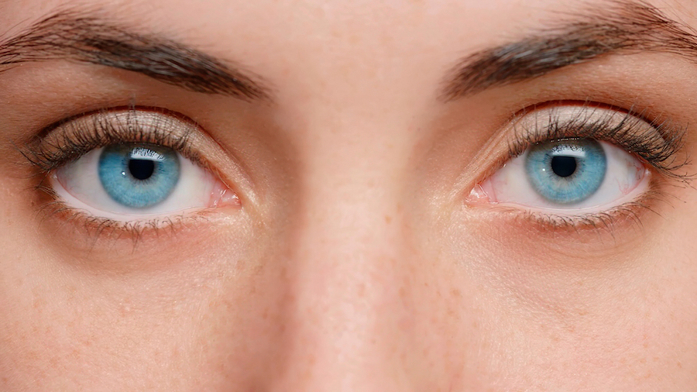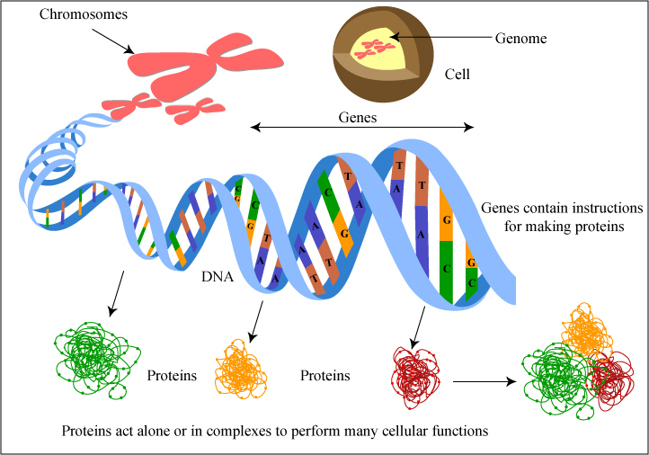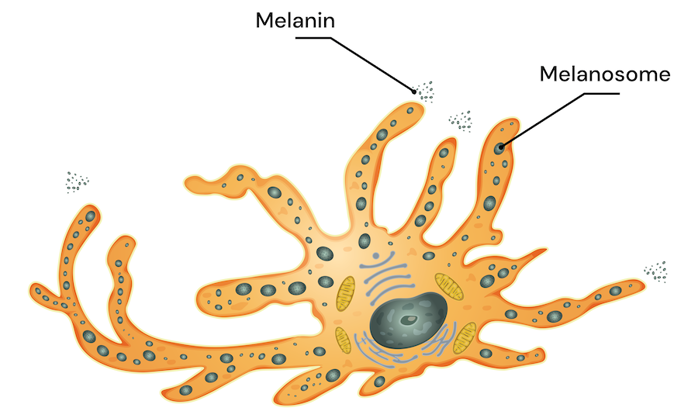
I was wondering how do you get from a gene to a blue eye?
July 16, 2009

- Related Topics:
- DNA basics,
- Genes to proteins,
- Genetic variation,
- Eye color,
- Pigmentation traits
A curious adult from California asks:
"I was wondering how do you get from a gene to a blue eye?"
This is a great question that gets to the heart of exactly what genes are and what they do. Genes are pieces of DNA, of course. But even though DNA is really important, it can't do all of the jobs needed to make your body work.
In fact, genes can't really do much on their own. To get anything done, a cell needs to read its genes, follow their instructions, and make proteins. After they're made, proteins work together to keep your body running.
Proteins have lots of different kinds of jobs. Some make your muscles contract and relax. Others help you think, see, walk, digest the food you eat, etc.
And some proteins help make a pigment called melanin. How much melanin gets made in your eye determines your eye color.
Some people have versions of these melanin-making genes that make proteins that make a lot of pigment. These folks have brown eyes. Other people have genes that make only a little bit of melanin making protein. Or the usual amounts of a defective one. These folks make little or no melanin and so have blue eyes.
To really understand how genes make melanin, we're going to have to go over a few topics. First, we'll review how genes code for proteins. Then we'll talk about how melanin is made. Finally, we'll get to blue eye gene versions and how they affect eye color.

Genes, Proteins, and Variations
Genes are written in a simple DNA language. There are only 4 letters: A, T, C, and G. The order of these letters in a gene determines which protein gets made.
Proteins are also written in a simple language. They are made up of 20 different letters called amino acids.
A cell translates the letters of DNA into the letters of proteins in two steps. (You can read more about these steps here.) The order of the amino acids in a protein determines what that protein does. Different people can have slightly different versions of the same genes. This is called genetic variation.
These differences can be a different DNA letter at a single spot in a gene. It can also be an extra or a missing letter. Sometimes it can even be a lot of letters of DNA that are different, added or go missing.
These differences in a gene can sometimes affect how a protein works by changing the amino acids in the protein. Or by altering how much of a protein gets made.
Blue eyes can happen for both reasons. Sometimes a pigment gene doesn't make enough protein so little or no melanin gets made. And sometimes the protein that does get made doesn't work well.
Let's go a little deeper and talk about how melanin gets made in the body. Then we can talk about how when some specific genes don't work quite right, people can end up with blue eyes.

Melanin is Made in Melanocytes
You've heard of cells before, right? They're all over your body. Cells make up your skin, heart, stomach, everything.
Different types of cells do different things. Some make important products that keep your body running. For example, the cells in your stomach have to make the acids and enzymes that break down the food you eat.
Melanin is made in special cells called melanocytes. There are melanocytes in your skin and eyes, as well as in hair roots. These cells are the reason skin, eye and hair have color.
To start thinking about how melanin is made, let's imagine each cell as a factory. There are lots of different steps to make one product at the end.
Making a car, for example, is a long process. Each piece is put together in an assembly line. Only after every piece is put together can you drive it.
Same thing with making melanin. Except that instead of workers, a melanocyte has proteins. These proteins act like workers in an assembly line and carry out the steps for making pigment in your body. They start out with a chemical called tyrosine.
One set of proteins changes the tyrosine bit by bit. Another set links these modified tyrosines together to make a long chain. The end result is melanin.
But making melanin doesn't just happen anywhere in the cell. The whole process happens in special compartments called melanosomes.
There are certain types of proteins that move components in or out of melanosomes. Kind of like delivery trucks that bring parts to factories.
When melanin is finally made, the skin, hair, and eyes darken. As long as melanin gets made, that is.
Remember when we were talking about how different gene versions can make slightly different versions of the same protein? Well, it is the differences in the genes for melanosome proteins that determine eye color.
One wrong step in an assembly can shut down the whole car factory. The same is true for melanin production.
If any of these proteins aren't working, there can be a big effect on the amount of pigment made. There are many proteins involved, so there are lots of spots where things can go wrong!

Blue Eyes Result from Differences in Melanosome Genes
One of the spots where melanin production can break down is in the delivery truck proteins. Remember, these are key proteins that move stuff in and out of melanosomes. OCA2 is a pretty famous example.
Sometimes blue eyes happen when there is a difference in the OCA2 gene so the deliveries don't get made. This is like a delivery truck with a flat tire or an engine blown out.
And sometimes a difference in a nearby gene, HERC2, causes less OCA2 to get made. This is like the delivery truck being carjacked.
Both of these differences result in less melanin getting made in the eyes. Which of course results in blue eyes. (You can read more about HERC2 and OCA2 here.)
OCA2 isn't the only important gene. If any of the melanosome genes have a difference that causes less protein or a defective protein to be made, that can mess up the whole factory. For example, TYR and TYRP1 are two of the assembly line worker proteins in melanin production.
Mutations in their genes reduce the amount of pigment made. This results in a lighter eye color. Depending on the mutation, this can mean blue eyes or even less pigment everywhere (albinism).
There are other genes that can cause blue eyes. But they all have something in common: they affect melanin, melanosomes, or melanocytes — the pigment-producing factories in your body.

Author: Mandi Hartman
When this answer was published in 2009, Mandi was a Ph.D. candidate in the Department of Biochemistry, studying cell biology of drosophila myosin VI in Jim Spudich’s laboratory. Mandi wrote this answer while participating in the Stanford at The Tech program.
 Skip Navigation
Skip Navigation
